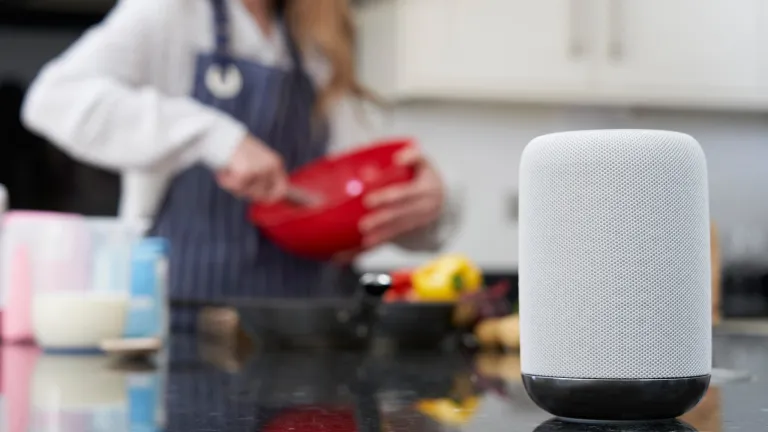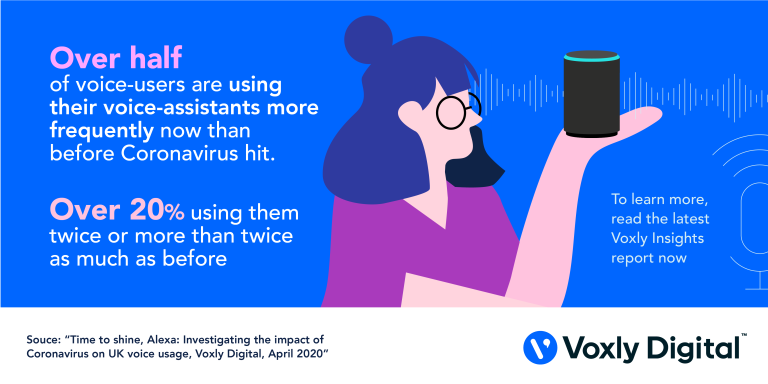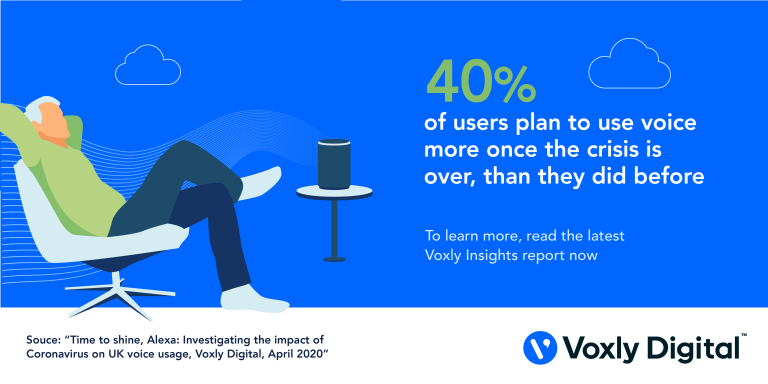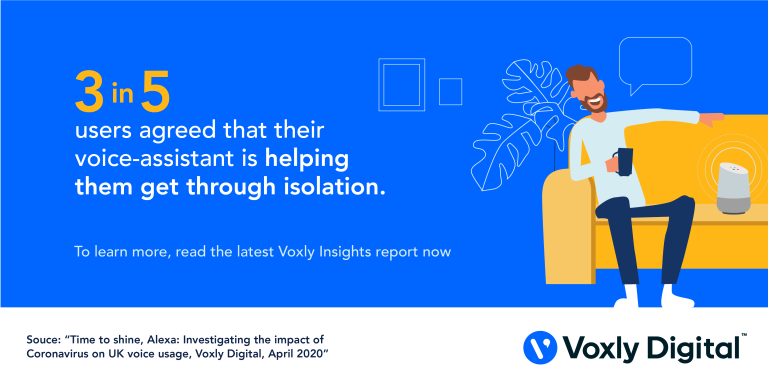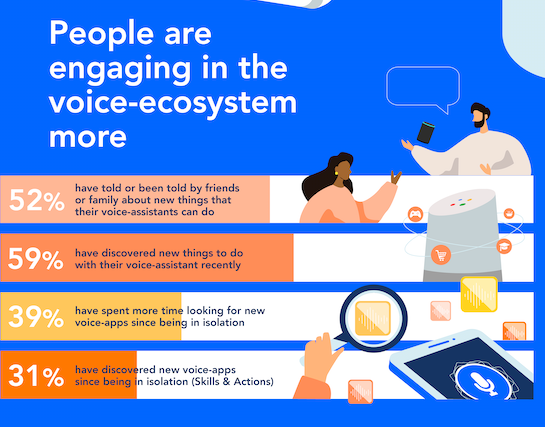After 4 months of sheltering-in-place and restricted movement, we are learning once again the lesson that “content is king.” Thank you, Bill Gates. This time, content has a cohort, the voice assistant. Recently, Voxly Digital completed a survey of voice assistant users to determine the impact of COVID-19 on voice usage. Their results, while unsurprising, bring to light some new growth opportunities for content providers and device manufacturers.
Their study also confirms what other studies have listed as the most common use cases for voice assistants: music, news, entertainment, and gaming. Historically, the providers of this content have relied on third-party devices as a channel to reach their audiences. More recently though, content providers are creating their own branded apps and partnering with voice AI technology providers in an effort to increase the number and fidelity of distribution channels for their content.
For those content providers that haven’t begun exploring more ways to distribute their content via new channels, this study is a wake-up call to own your content, audiences, and consumer data.
Voice assistant usage is growing and changing
According to some experts, it takes most people 30 days to establish new habits and new routines. Since the lockdown started for most people in mid-March, we are well into more than 3 times that time as routines have mostly remained unaltered and socializing outside of the home severely curtailed. During that time, people have turned to their voice assistants to help them pass the time, entertain their kids, and stay informed.
As a result, the already rapid adoption of voice assistants got a boost. According to the survey, most people are using their voice assistants more than before the shelter-in-place orders, and over 20% are using them up to twice as much.
And while we can point to previous studies that predicted the acceleration of voice usage globally, content providers and brands considering a voice-first approach can take comfort in knowing that habits have been formed and people don’t expect to abandon them at the first sign of “normalcy.” In fact, 40% of voice assistant users intend on continuing to use voice interfaces more than before SIP—after having an opportunity to become more familiar and comfortable with them.
To take this trend one step further, brands should consider that consumers are not only planning to use voice more, but may have higher expectations for voice interfaces with their mobile apps and other devices. Smart home devices, cars, restaurant ordering kiosks, and many other applications may emerge as necessary use cases for voice user interfaces in the short and long-term as people expect their convenience to extend beyond the home.
Content providers of recipes, music, news and entertainment, food delivery, and other services should be aggressively creating voice solutions to meet these market needs—and get there ahead of the competition. Developing a wholly-owned, independent voice-enabled mobile app is key to realizing greater engagement, user growth, and brand ownership for content providers.
People are seeking more voice-enabled services at home, and outside
Multiple studies that reported on the increasing voice assistant usage and growth have been used as a bellwether for the adoption of voice-first strategies across industries. In Voxly’s report, they specifically honed in on the most obvious location-based use cases during shelter-in-place—the home. Their study reflects what we may have already intuited, that people relied on their voice assistants to help get them through the rigors of extended isolation.
Whether to get news updates on the status of the virus and to understand the global impact, or to escape through music, entertainment, and games, people found their voice assistants comforting. For individuals who live alone, having another voice in the house made it seem a little less empty, and for those with children home from school, providing another source of distraction brought relief.
Other at-home use cases included learning to cook and trying new recipes. Even the way people searched via voice has changed as they sought to find recipes that included only the ingredients they had on hand—since getting additional ingredients wasn’t the simple run to the store that it used to be. Other folks learned new skills and played trivia games to keep their minds occupied.
The at-home use cases most commonly used by the participants of this survey indicate an opportunity for more voice-enabled home products but also outside of their homes in cars, stores, etc. As people accept voice interfaces and embrace them, offering appliances and other products with embedded voice interfaces is a low-cost opportunity for manufacturers. In addition, gamers would likely embrace a voice interface that enhanced their experiences and unlocked more functionality.
Discovery is less of a challenge
User adoption and device discoverability is one of the greatest challenges in the new era of voice. In the last four months however, as people’s lives have slowed down, this has changed. They have made time for things that they didn’t have time for before. One result of the extra time and uncluttered schedules has been that people are taking the time to explore the capabilities of voice assistants.
According to the report, people are also sharing that knowledge—lessening the burden of education on the platform and content providers. The very fact that people are exploring voice apps on their own and finding new use cases for their voice assistants and then sharing that information with friends is an indicator that they will be more likely to self-educate on new devices and voice-enabled apps.
User self-discovery eliminates one of the three greatest challenges of implementing a voice-first strategy and further lowers the barriers to entry for new devices or for brands just getting started with voice-enabled apps and devices. Other challenges of adding voice AI to your company roadmap are becoming less difficult as brands now have some clear-cut guidelines for finding their unique voice. Monetizing the voice investment is becoming easier as more brands enter the arena, creating greater opportunities.
Growing confidence leads to greater engagement
For better or for worse, the pandemic has changed our world forever. No matter how or when the immediate crisis ends, the changes in how we see the world and the shifts in our priorities are permanent. We’ve already formed new habits and changed behaviors that aren’t likely to change back anytime soon.
As brands and individuals, we have choices about how we respond to these changes. We can either grieve the normalcy we lost or we can embrace our new normalcy and seize the opportunities our altered lifestyles are presenting.
People are spending more time with family, discovering real work-life balance, and focusing on enjoying the little pleasures life has to offer. We’ve grown more comfortable with the technology that has been available, but for which we have not had the time to really learn. In fact, over half the people in the study reported feeling more confident using their voice assistant, and 45% consider their assistants more useful. These facts alone should make brands want to seize the opportunity before them to join the voice-first revolution and capitalize on this new, open, and eager market.
Historically, innovation has always accelerated after a major crisis, whether it’s a pandemic or a war. We saw that happen after the great plague as the Renaissance Period was born, and after the last world war when the technological revolution began. This crisis has opened up new opportunities for brands and may be the catalyst to speeding up a more voice-enabled world. Content providers and device and auto manufacturers who seize the moment and make the leap to a voice-first strategy may well be the leaders in this new era of voice.
Houndify, our independent Voice AI platform, allows developers to build a custom voice assistant with a branded wake word for any product, mobile app, or service. Our mission is to enable humans to interact with the things around them like we interact with each other: by speaking naturally to phones, cars, smart speakers, mobile apps, coffee machines, and every other part of the emerging ‘voice-first’ world. If you’re interested in exploring the Houndify voice AI platform further, visit Houndify.com to learn more and register for a free trial account.
Karen Scates is a storyteller with a passion for helping others through content. Argentine tango, good books and great wine round out Karen’s interests.


